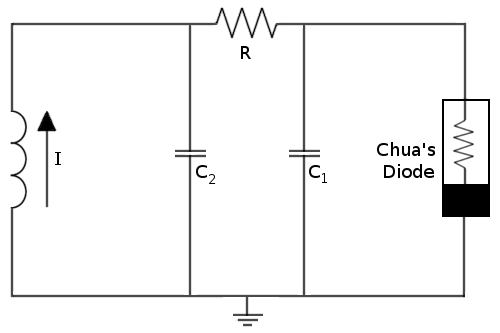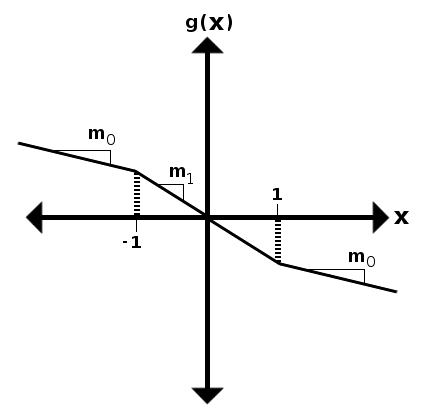
FIGURE A:
basic chua's circuit schematic

Here is a diagram of Chua's circuit. As you can see, the design is relatively straightforward. In fact, it is the simplest possible chaotic circuit. There are a few variations but this is the most basic design. Building this circuit requires only basic soldering skills and a few common circuit components.
basic chua's circuit schematic

FIGURE B:
chua's diode resistance graph

Chua's circuit can be modelled by a set of nonlinear differential equations where x, y and z are plotted against time, commonly represented as follows.
Chua equations: ẋ = α(y-x-g(x)) ẏ = x-y+z ż = -βy
These represent the voltages across capacitors C1, C2 and the current of the inductor respectively, as denoted in the schematic above. α and β depend on the actual circuit components. g(x) is a piecewise-linear function representing the change in resistance vs. current across the Chua Diode:
g(x) = {m0x+m0-m1, if x≤-1
{m1x, if -1≤x≤1
{m0x+m1-m0, if 1≤x
Here m1 is the slope of the middle segment and m0 is the slope of the two outer segments.Check out our simulation to see these equations plotted in 3 dimensions.
We can, however, represent these explicitly as functions of components, voltages and resistance in the actual circuit as below:
̇v1 = [ 1/(R*C1) ]( (v2-v1)-R*g(v1) )
̇v2 = [ 1/(R*C2) ]( v1 -v2+R*iL )
̇iL = [ 1/(L) ]( -v2 )
g(v1) = {m0 v1 + (m0-m1)E1, if v1 ≤ -E1
{m1v1, if -E1 < v1 < E1
{m0 v1 + (m1-m0)E1, if E1 ≤ v1



